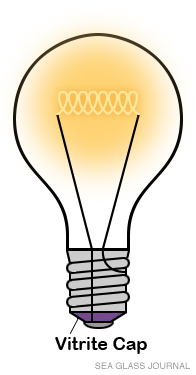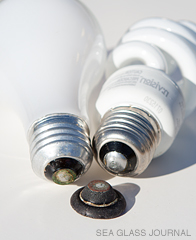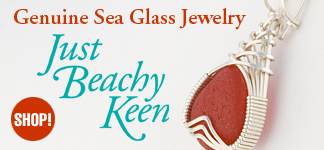
The vitrite cap is located at the base of a light bulb.
Of Vitrite & Light Bulbs
In common incandescent light bulbs the electricity used to heat up the tungsten filament producing that familiar glow comes from contacts originating in the base of the bulb. One contact is connected to the screw cap, or sleeve, and the other stems up the center from the bottom of the base. These contacts have to be insulated from one another or current will not flow through the tungsten filament. That's where the vitrite comes in. It surrounds the contact that comes up from the bottom of the bulb and insulates it from the contact connected to the metal sleeve.

Incandescent light bulbs and compact fluorescent lamps (CFLs) still use the vitrite caps.
Facts of Interest
Alfred Swan, the inventor of vitrite, eventually emigrated to the USA and took up employment at General Electric's Euclid Lamp Works.
In a standard incandescent bulb, in which the filament is electrified until it glows, only about 10 percent of the electricity is transformed into light; the rest generates heat as a side effect.
The Energy Independence and Security Act of 2007, created to move the United States toward greater energy independence and security, will phase out the common but inefficient incandescent light bulbs for general lighting by this year (2014), in favor of more energy-efficient lighting alternatives such as compact fluorescent lamps (CFLs).
Before the use of vitrite to insulate the contacts, base designs incorporated wood, plaster of Paris or porcelain, which were all found to be impractical for one reason or another. In the late 1800s Alfred Swan, brother of brother of Sir Joseph Wilson Swan of early electric incandescent lamp fame, invented vitrite[1], the special black glass for the purpose of securing and insulating the electrical filament contacts at the base of incandescent lamps.
Since 1902, when vitrite was first molded into a cap shape to be used at the base of the light bulb, the design has changed little and is still used in incandescent light bulbs and compact fluorescent lamps (CFLs) today.
REFERENCES:
1. http://www.lamptech.co.uk/Documents/Factory%20-%20UK%20-%20Benwell.htm






